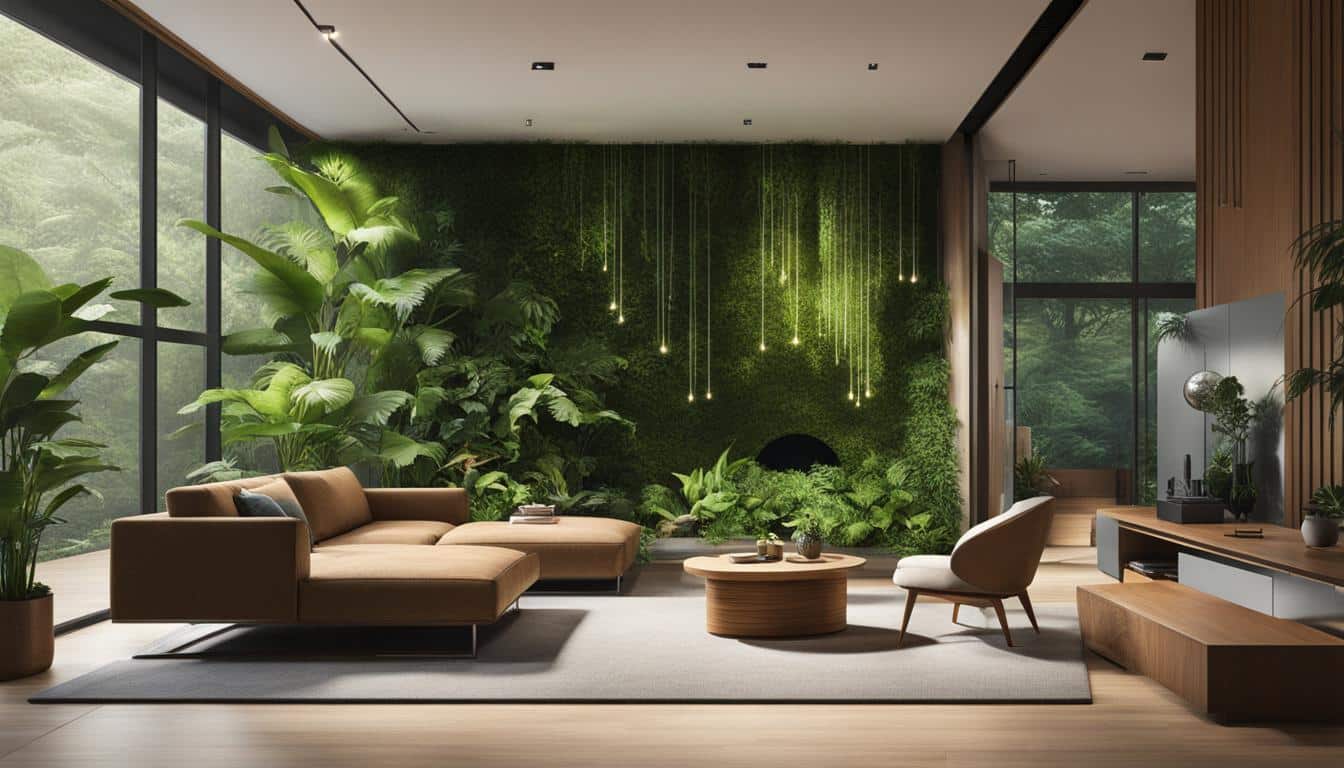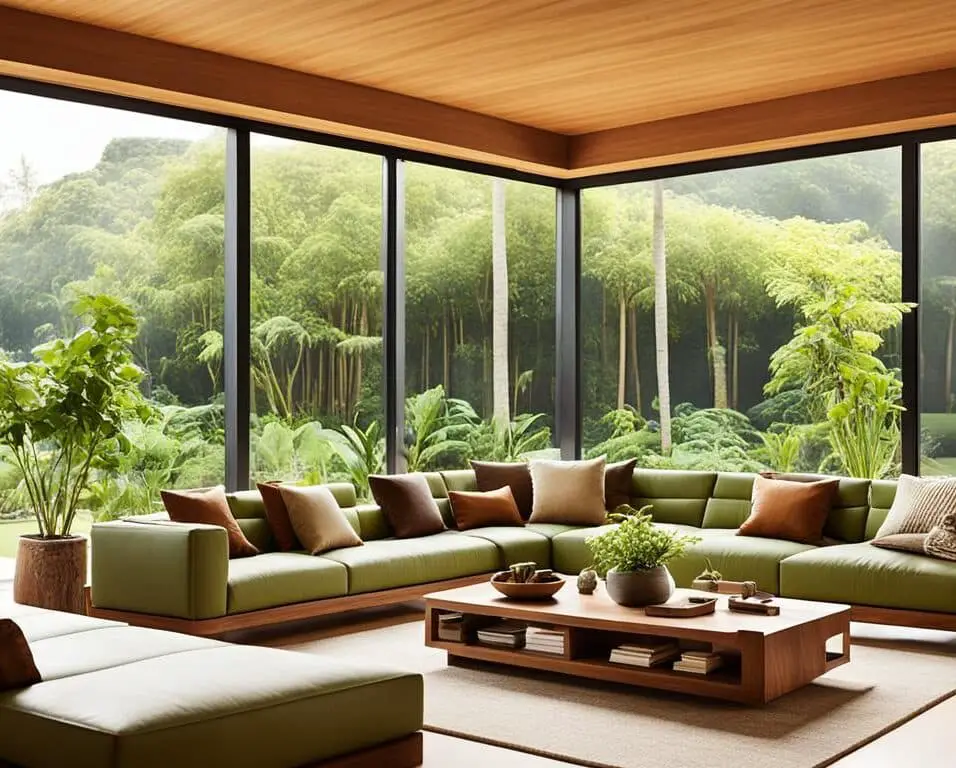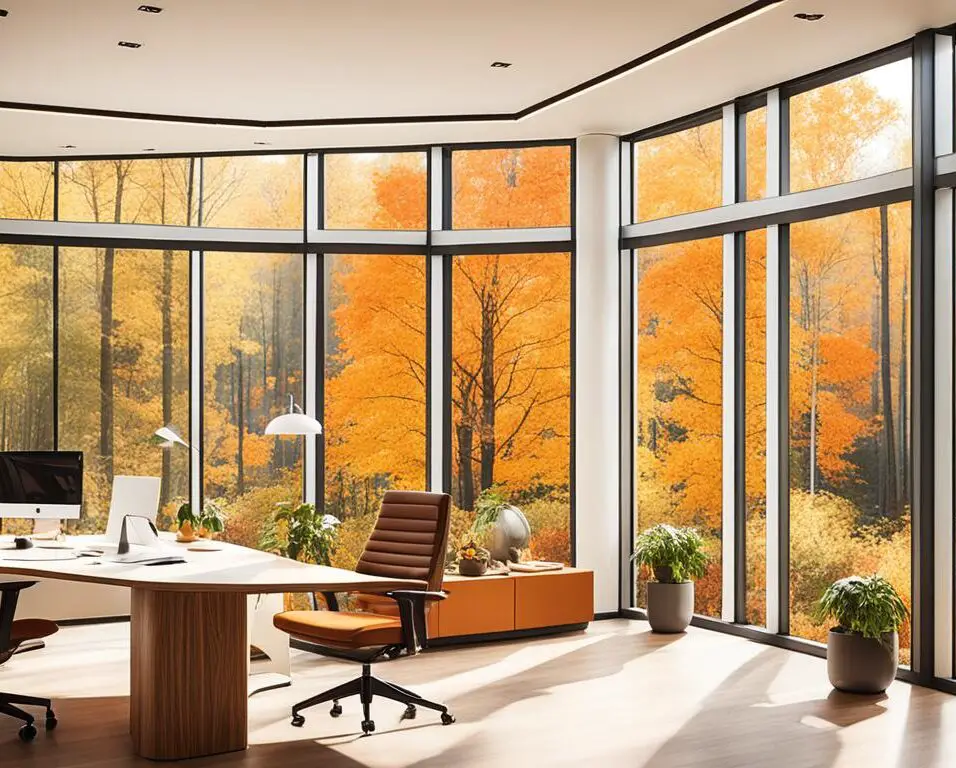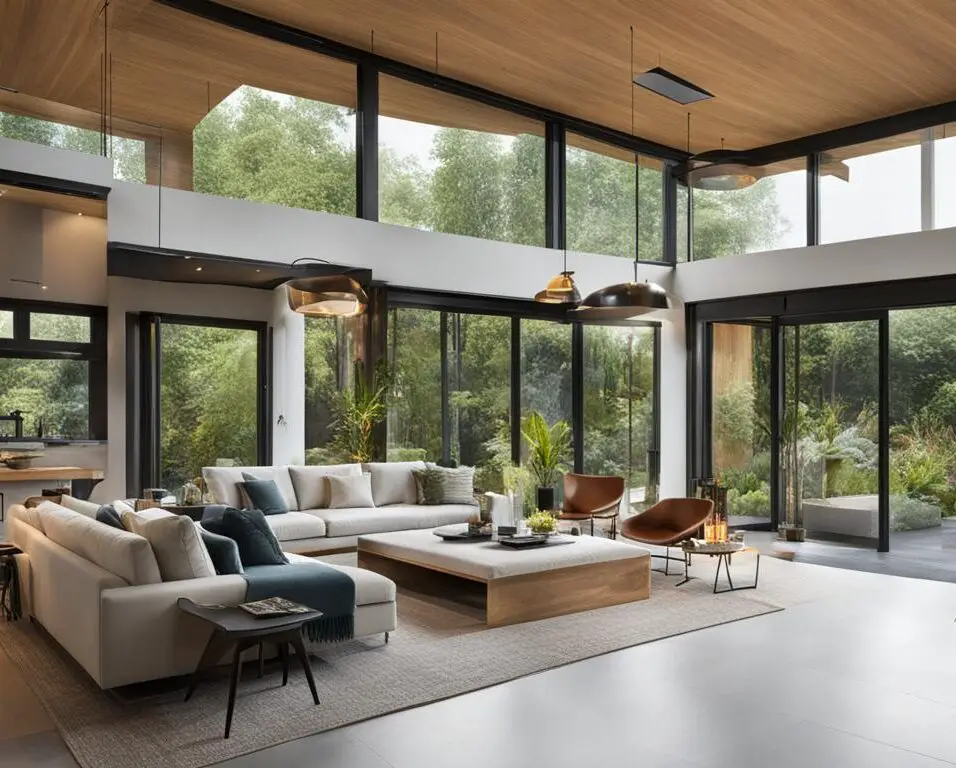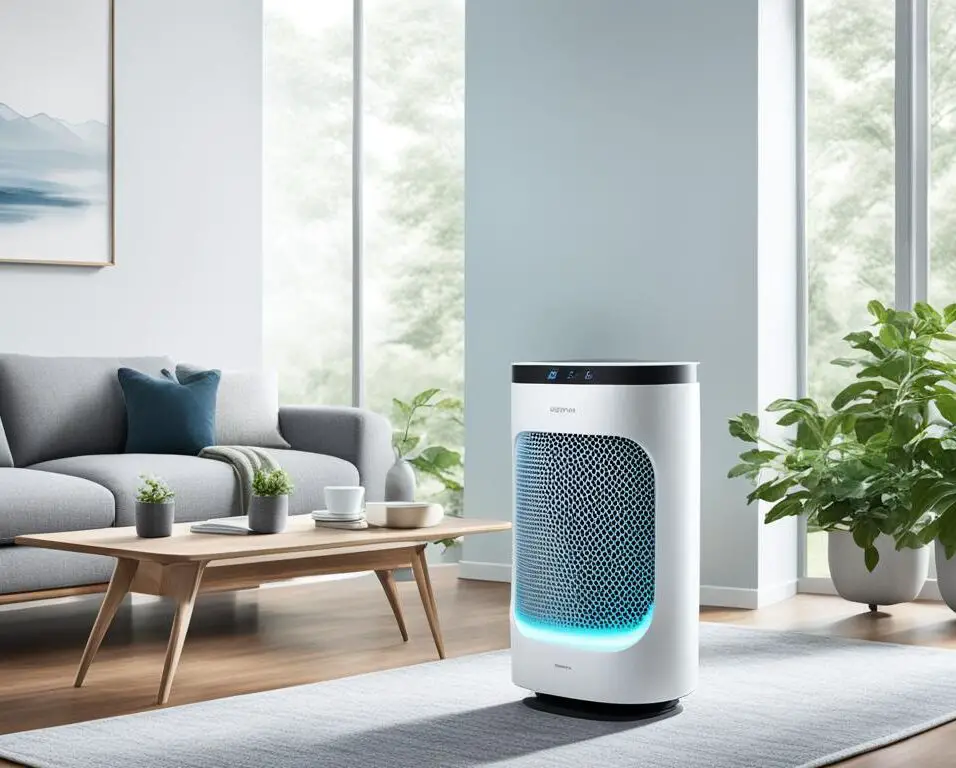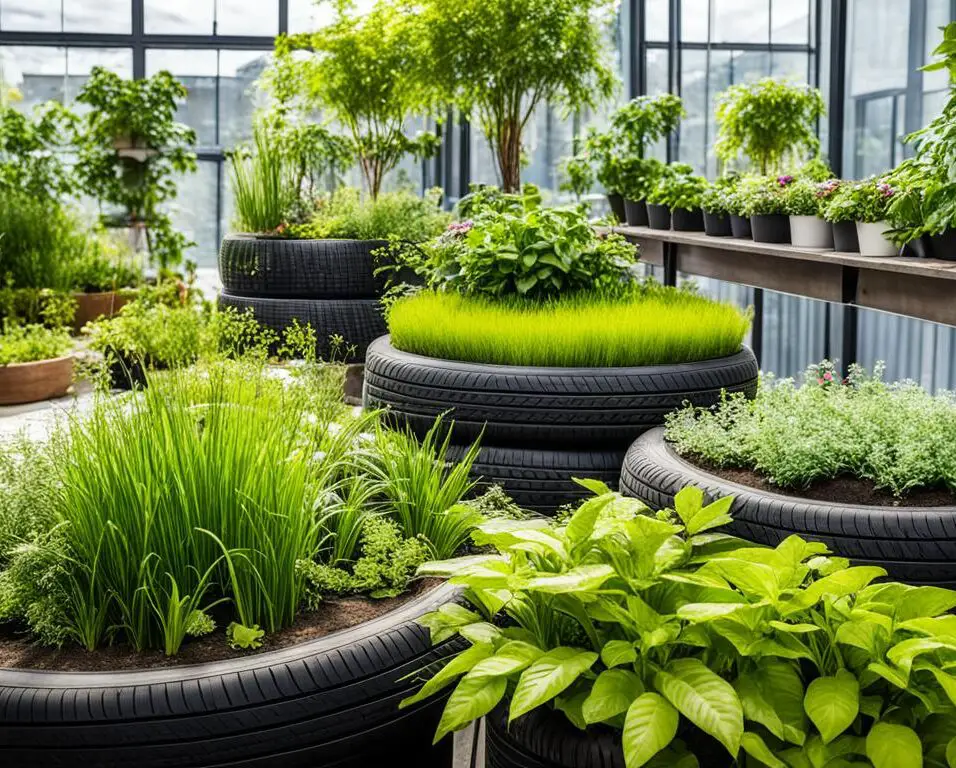Sounds of Nature: Soundscaping in Biophilic Interior Design
As a writer and enthusiast of interior design, I have always been fascinated by the power of our environment to shape our well-being. Recently, I came across an intriguing concept that combines the beauty of nature with the art of design – biophilic interior design. This innovative approach goes beyond just bringing plants into our living spaces; it incorporates all elements of nature, including sound, to create a harmonious and rejuvenating environment.
In this article, I will explore the captivating world of soundscaping in biophilic interior design. We will delve into the benefits it offers, how it can be incorporated into different spaces, even on a budget, and its potential in commercial settings. So, join me as we uncover the transformative power of sound in creating a connection between the built environment and the natural world.
Key Takeaways:
- Biophilic interior design incorporates natural elements, including sound, to create a balanced and revitalizing living environment.
- Research shows that incorporating natural sounds like birdsong and rustling leaves can reduce stress and improve mood.
- Biophilic design offers numerous benefits, including reduced stress, improved cognitive function, and enhanced creativity.
- It can be incorporated into spaces through elements such as natural light, ventilation, natural materials, water features, and bioacoustics.
- Even on a budget, biophilic design can be achieved through careful selection of low-maintenance plants, utilizing natural materials, and DIY water features.
The Benefits of Biophilic Design
Biophilic design offers numerous benefits that contribute to creating healthier and more harmonious living and working environments. By incorporating elements inspired by nature, such as natural light, ventilation, organic materials, water features, and even natural sounds, biophilic design has been shown to have a positive impact on our well-being and productivity.
Research studies conducted by various universities and institutes have consistently demonstrated the advantages of biophilic design. These benefits include:
- Reduced stress and anxiety: Connecting with nature through biophilic design elements has been shown to help lower stress levels and alleviate feelings of anxiety, promoting a sense of calmness and relaxation.
- Improved cognitive function and productivity: Exposure to nature-inspired elements can enhance cognitive performance and increase productivity. Studies have indicated that individuals working or studying in biophilic environments exhibit higher levels of focus, concentration, and problem-solving abilities.
- Enhanced mood and creativity: Biophilic design has the power to improve mood and boost creativity. Natural elements and patterns found in nature have a profound impact on our emotional well-being, positively influencing our overall mental state and fostering a more creative mindset.
- Increased employee retention and reduced absenteeism: Implementing biophilic design in workplaces has been linked to higher job satisfaction, increased employee retention rates, and reduced absenteeism. Creating an environment that connects individuals to nature and promotes well-being can contribute to a happier and healthier workforce.
These benefits highlight the transformative effect of biophilic design on our physical, mental, and emotional well-being, making it a relevant and essential consideration in the field of interior design.
Biophilic design is not limited to simply adding plants to a space. It encompasses a holistic approach that embraces various elements to mimic nature’s presence, creating a more naturalistic and harmonious environment. The use of natural light, ventilation, organic materials, water features, and even bioacoustics are key components of biophilic design that work together to create a connection with the natural world.
Maximizing Natural Light and Ventilation
One of the key aspects of incorporating biophilic design into spaces is maximizing natural light and ventilation. Sunlight not only adds warmth and brightness to a space but also provides a connection with the natural world outside. By strategically placing windows, skylights, or glass walls, natural light can be harnessed to create a soothing and inviting atmosphere. Additionally, proper ventilation ensures a constant flow of fresh air, creating a healthier indoor environment.
Using Natural Materials
A fundamental principle of biophilic design is using natural materials like wood and stone. These materials not only bring a touch of nature into the space but also have a calming and grounding effect. Hardwood floors, wooden furniture, or stone accents can add texture and visual interest while fostering a sense of harmony and tranquility.
Creating Water Features
Water features such as fountains or indoor ponds are another effective way to incorporate biophilic design in spaces. The sight and sound of flowing water evoke a sense of serenity and promote relaxation. Water features can be placed strategically to serve as focal points, bringing a dynamic element to the overall design.
Incorporating Natural Sounds
To create a truly immersive experience, biophilic design incorporates natural sounds like birdsong, rustling leaves, or gentle rain. These sounds can be integrated using sound systems or through the use of nature sound apps or online playlists. The calming effect of natural sounds enhances the overall ambiance of the space, promoting a sense of tranquility and well-being.
By incorporating these elements, biophilic design creates a multi-sensory experience that brings the outdoors in, fostering a deeper connection with nature and improving the overall well-being of individuals in the space.
Biophilic Design on a Budget
Biophilic design doesn’t have to break the bank. There are many affordable ways to incorporate biophilic elements into your spaces. By making smart choices and getting creative, you can bring the beauty of nature indoors without exceeding your budget.
Here are some budget-friendly ideas to help you achieve a biophilic design:
- Choose Low-Maintenance Houseplants: Opt for houseplants that require minimal care and can thrive in various light conditions. Some popular low-maintenance options include pothos, snake plants, and ZZ plants.
- Maximize Natural Light: Utilize curtains and blinds to control the amount of natural light entering your space. This not only helps create a connection with the outdoors but also saves money by reducing the need for artificial lighting.
- Use Natural Materials: Incorporate sustainable and cost-effective materials like bamboo or reclaimed wood in your furniture, flooring, or decor. These materials add a touch of nature while being environmentally friendly.
- Create DIY Water Features: Bring the soothing sound of water into your space by crafting your own water features. You can use pumps, pebbles, and even repurpose items to create budget-friendly fountains or small indoor ponds.
- Utilize Free Nature Sound Apps: Enhance the biophilic experience by incorporating nature sounds. Download free nature sound apps or explore online playlists that offer a variety of calming sounds like rain, waves, or forest ambiance.
Remember, even small touches of biophilic design can have a significant impact on your well-being. By being resourceful and mindful of your budget, you can create a space that embraces the healing power of nature.
Take a look at the table below for a cost comparison of various biophilic design elements:
| Biophilic Design Element | Cost Range |
|---|---|
| Low-Maintenance Houseplants | $10-$50 per plant |
| Curtains and Blinds | $20-$100 per window |
| Natural Materials (e.g., Bamboo, Reclaimed Wood) | $30-$200 per item |
| DIY Water Features | $50-$200 |
| Free Nature Sound Apps | $0 |
Bringing Nature Indoors on a Budget
“Biophilic design allows us to reconnect with nature and experience its positive effects without straining our wallets. Whether it’s through affordable houseplants, harnessing natural light, or incorporating reclaimed materials, everyone can enjoy the benefits of biophilic design on a budget.” – Jessica Green, Biophilic Design Expert
Incorporating biophilic design doesn’t have to be a luxury reserved for high-end projects. With these budget-friendly ideas, you can create a space that promotes well-being, productivity, and a deeper connection to the natural world.
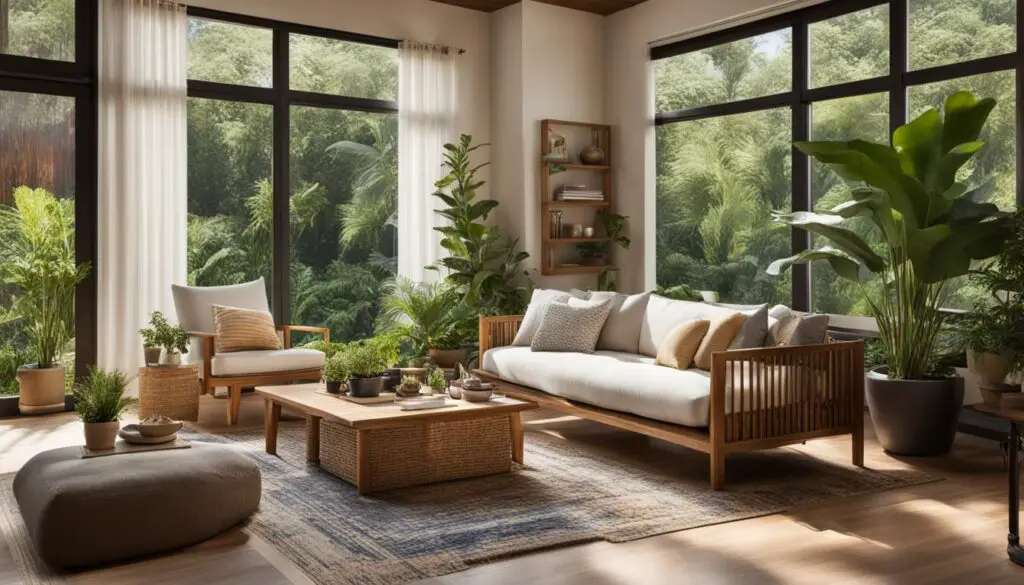
Biophilic Design in Commercial Spaces
Biophilic design is not limited to residential spaces; it can also be successfully applied in commercial settings. Research conducted by the International Living Future Institute has shown that incorporating biophilic elements into workplaces can have significant positive impacts on productivity and employee well-being.
Companies such as Apple, Amazon, and Unilever have embraced biophilic design principles in their office spaces, recognizing the benefits it brings. By incorporating natural elements, these companies have created healthier and more productive work environments for their employees.
The Benefits of Biophilic Design in Commercial Spaces
1. Increased Productivity: Studies have found that incorporating biophilic elements in commercial spaces can lead to a significant increase in employee productivity. The presence of natural elements, such as plants and views of nature, can reduce stress, improve focus, and enhance cognitive function.
2. Reduced Absenteeism: Biophilic design has also been linked to a decrease in absenteeism. Providing employees with a visually appealing and nature-inspired workspace can help create a sense of well-being and reduce stress levels, resulting in fewer sick days.
“A well-designed workplace that incorporates biophilic elements can lead to happier, healthier, and more engaged employees, ultimately boosting overall performance and success.” – Your Company Name
Creating Biophilic Commercial Spaces
Incorporating biophilic design into commercial spaces can be achieved through several strategies:
- Integrate natural elements: Incorporate plants, water features, and natural materials, such as wood and stone, into the design of the space.
- Maximize natural light: Prioritize natural light by optimizing window placement, using window treatments that allow for ample daylight, and utilizing light shelves or skylights.
- Provide views of nature: Whenever possible, design spaces that offer views of outdoor greenery or natural landscapes.
- Create biophilic work areas: Set up dedicated areas that can serve as retreats or breakout spaces, incorporating natural elements to create a soothing and rejuvenating environment.
By implementing these strategies, commercial spaces can harness the power of biophilic design to enhance employee well-being, productivity, and overall job satisfaction.
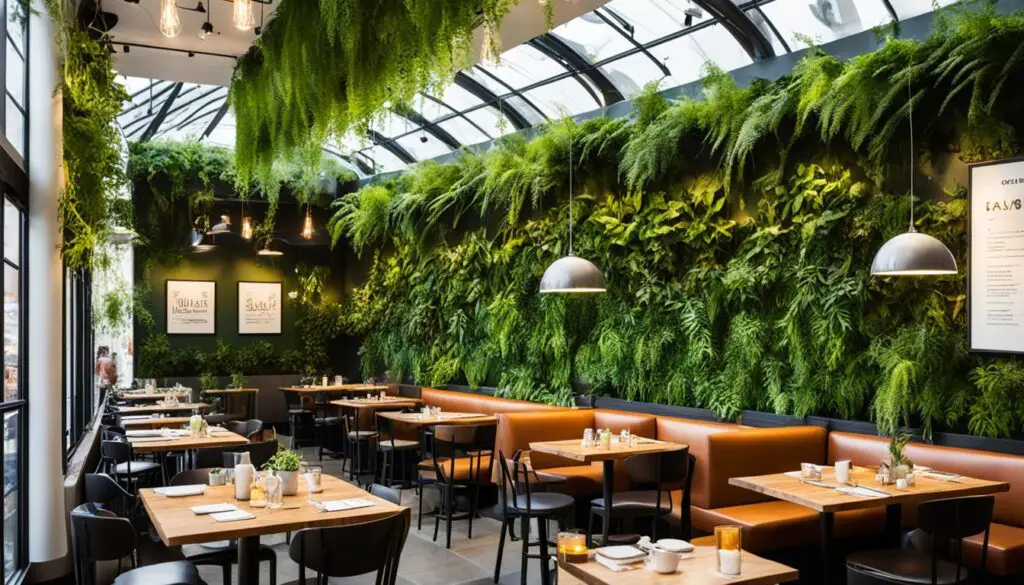
Biophilic design in commercial spaces promotes a connection to nature and fosters creativity and collaboration among employees. By infusing workplaces with elements inspired by the natural world, companies can create environments that contribute to the overall well-being and success of their workforce.
Conclusion
Biophilic design is a transformative approach to interior design that recognizes the profound connection between humans and nature. By incorporating natural elements into built spaces, such as plants, natural light, and water features, biophilic design offers a multitude of benefits for our well-being and productivity.
Studies have shown that biophilic design can reduce stress levels, improve cognitive function, enhance mood and creativity, and even increase employee retention in commercial spaces. The incorporation of biophilic elements can be done within different budget constraints, making it accessible for both residential and commercial settings.
Biophilic design is not just a passing trend; it represents a fundamental shift in our relationship with the built environment. It encourages us to embrace nature as an integral part of our daily lives and fosters a deeper appreciation for its positive impact on our physical and mental well-being. By incorporating biophilic design principles, we can create spaces that not only look beautiful but also promote a sense of harmony and connection with the natural world.
FAQ
What is biophilic design?
Biophilic design is a trend in interior design that incorporates natural elements into built spaces, creating a connection to nature.
What are the benefits of biophilic design?
Biophilic design offers numerous benefits including reduced stress and anxiety, improved cognitive function and productivity, enhanced mood and creativity, and increased employee retention and reduced absenteeism.
How can I incorporate biophilic design into spaces?
You can incorporate biophilic design by maximizing natural light and ventilation, using natural materials, creating water features, and incorporating natural sounds like birdsong.
Is biophilic design expensive?
No, there are budget-friendly options for incorporating biophilic elements into spaces such as using low-maintenance houseplants, maximizing natural light with curtains and blinds, and utilizing free nature sound apps or online playlists.
Can biophilic design be used in commercial spaces?
Yes, biophilic design can be used in commercial spaces with great success. It has been shown to increase productivity and reduce absenteeism in workplaces.
Is biophilic design just a trend?
No, biophilic design is a fundamental shift in our relationship with the built environment, fostering a deeper appreciation for nature and its impact on our well-being.



